Chenglizhao Chen
Unveiling Context-Related Anomalies: Knowledge Graph Empowered Decoupling of Scene and Action for Human-Related Video Anomaly Detection
Sep 05, 2024Abstract:Detecting anomalies in human-related videos is crucial for surveillance applications. Current methods primarily include appearance-based and action-based techniques. Appearance-based methods rely on low-level visual features such as color, texture, and shape. They learn a large number of pixel patterns and features related to known scenes during training, making them effective in detecting anomalies within these familiar contexts. However, when encountering new or significantly changed scenes, i.e., unknown scenes, they often fail because existing SOTA methods do not effectively capture the relationship between actions and their surrounding scenes, resulting in low generalization. In contrast, action-based methods focus on detecting anomalies in human actions but are usually less informative because they tend to overlook the relationship between actions and their scenes, leading to incorrect detection. For instance, the normal event of running on the beach and the abnormal event of running on the street might both be considered normal due to the lack of scene information. In short, current methods struggle to integrate low-level visual and high-level action features, leading to poor anomaly detection in varied and complex scenes. To address this challenge, we propose a novel decoupling-based architecture for human-related video anomaly detection (DecoAD). DecoAD significantly improves the integration of visual and action features through the decoupling and interweaving of scenes and actions, thereby enabling a more intuitive and accurate understanding of complex behaviors and scenes. DecoAD supports fully supervised, weakly supervised, and unsupervised settings.
Colorectal Polyp Segmentation in the Deep Learning Era: A Comprehensive Survey
Jan 22, 2024Abstract:Colorectal polyp segmentation (CPS), an essential problem in medical image analysis, has garnered growing research attention. Recently, the deep learning-based model completely overwhelmed traditional methods in the field of CPS, and more and more deep CPS methods have emerged, bringing the CPS into the deep learning era. To help the researchers quickly grasp the main techniques, datasets, evaluation metrics, challenges, and trending of deep CPS, this paper presents a systematic and comprehensive review of deep-learning-based CPS methods from 2014 to 2023, a total of 115 technical papers. In particular, we first provide a comprehensive review of the current deep CPS with a novel taxonomy, including network architectures, level of supervision, and learning paradigm. More specifically, network architectures include eight subcategories, the level of supervision comprises six subcategories, and the learning paradigm encompasses 12 subcategories, totaling 26 subcategories. Then, we provided a comprehensive analysis the characteristics of each dataset, including the number of datasets, annotation types, image resolution, polyp size, contrast values, and polyp location. Following that, we summarized CPS's commonly used evaluation metrics and conducted a detailed analysis of 40 deep SOTA models, including out-of-distribution generalization and attribute-based performance analysis. Finally, we discussed deep learning-based CPS methods' main challenges and opportunities.
Rethinking Object Saliency Ranking: A Novel Whole-flow Processing Paradigm
Dec 06, 2023



Abstract:Existing salient object detection methods are capable of predicting binary maps that highlight visually salient regions. However, these methods are limited in their ability to differentiate the relative importance of multiple objects and the relationships among them, which can lead to errors and reduced accuracy in downstream tasks that depend on the relative importance of multiple objects. To conquer, this paper proposes a new paradigm for saliency ranking, which aims to completely focus on ranking salient objects by their "importance order". While previous works have shown promising performance, they still face ill-posed problems. First, the saliency ranking ground truth (GT) orders generation methods are unreasonable since determining the correct ranking order is not well-defined, resulting in false alarms. Second, training a ranking model remains challenging because most saliency ranking methods follow the multi-task paradigm, leading to conflicts and trade-offs among different tasks. Third, existing regression-based saliency ranking methods are complex for saliency ranking models due to their reliance on instance mask-based saliency ranking orders. These methods require a significant amount of data to perform accurately and can be challenging to implement effectively. To solve these problems, this paper conducts an in-depth analysis of the causes and proposes a whole-flow processing paradigm of saliency ranking task from the perspective of "GT data generation", "network structure design" and "training protocol". The proposed approach outperforms existing state-of-the-art methods on the widely-used SALICON set, as demonstrated by extensive experiments with fair and reasonable comparisons. The saliency ranking task is still in its infancy, and our proposed unified framework can serve as a fundamental strategy to guide future work.
WinDB: HMD-free and Distortion-free Panoptic Video Fixation Learning
May 23, 2023Abstract:To date, the widely-adopted way to perform fixation collection in panoptic video is based on a head-mounted display (HMD), where participants' fixations are collected while wearing an HMD to explore the given panoptic scene freely. However, this widely-used data collection method is insufficient for training deep models to accurately predict which regions in a given panoptic are most important when it contains intermittent salient events. The main reason is that there always exist "blind zooms" when using HMD to collect fixations since the participants cannot keep spinning their heads to explore the entire panoptic scene all the time. Consequently, the collected fixations tend to be trapped in some local views, leaving the remaining areas to be the "blind zooms". Therefore, fixation data collected using HMD-based methods that accumulate local views cannot accurately represent the overall global importance of complex panoramic scenes. This paper introduces the auxiliary Window with a Dynamic Blurring (WinDB) fixation collection approach for panoptic video, which doesn't need HMD and is blind-zoom-free. Thus, the collected fixations can well reflect the regional-wise importance degree. Using our WinDB approach, we have released a new PanopticVideo-300 dataset, containing 300 panoptic clips covering over 225 categories. Besides, we have presented a simple baseline design to take full advantage of PanopticVideo-300 to handle the blind-zoom-free attribute-induced fixation shifting problem. Our WinDB approach, PanopticVideo-300, and tailored fixation prediction model are all publicly available at https://github.com/360submit/WinDB.
Pixel is All You Need: Adversarial Trajectory-Ensemble Active Learning for Salient Object Detection
Dec 13, 2022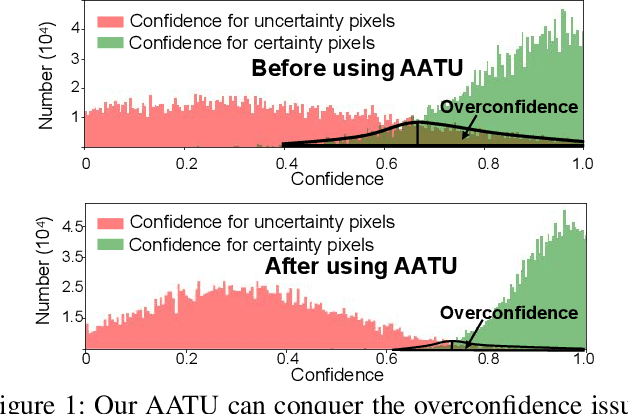

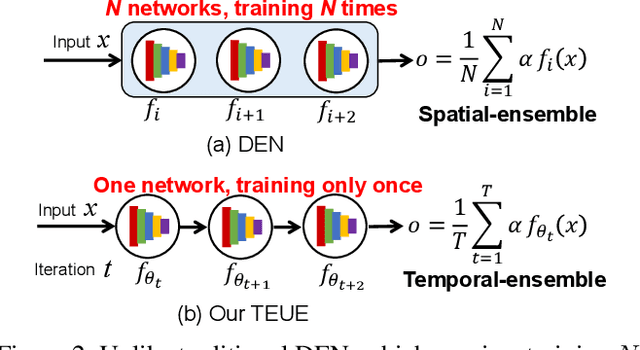
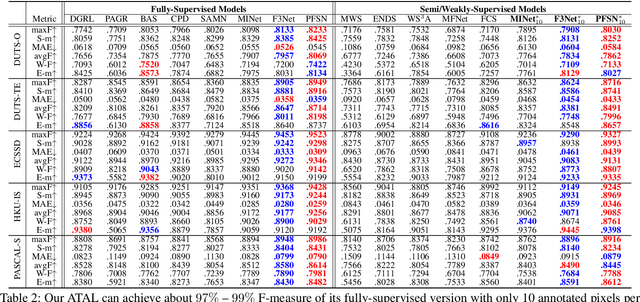
Abstract:Although weakly-supervised techniques can reduce the labeling effort, it is unclear whether a saliency model trained with weakly-supervised data (e.g., point annotation) can achieve the equivalent performance of its fully-supervised version. This paper attempts to answer this unexplored question by proving a hypothesis: there is a point-labeled dataset where saliency models trained on it can achieve equivalent performance when trained on the densely annotated dataset. To prove this conjecture, we proposed a novel yet effective adversarial trajectory-ensemble active learning (ATAL). Our contributions are three-fold: 1) Our proposed adversarial attack triggering uncertainty can conquer the overconfidence of existing active learning methods and accurately locate these uncertain pixels. {2)} Our proposed trajectory-ensemble uncertainty estimation method maintains the advantages of the ensemble networks while significantly reducing the computational cost. {3)} Our proposed relationship-aware diversity sampling algorithm can conquer oversampling while boosting performance. Experimental results show that our ATAL can find such a point-labeled dataset, where a saliency model trained on it obtained $97\%$ -- $99\%$ performance of its fully-supervised version with only ten annotated points per image.
* 9 pages, 8 figures
Salient Object Detection via Dynamic Scale Routing
Oct 25, 2022



Abstract:Recent research advances in salient object detection (SOD) could largely be attributed to ever-stronger multi-scale feature representation empowered by the deep learning technologies. The existing SOD deep models extract multi-scale features via the off-the-shelf encoders and combine them smartly via various delicate decoders. However, the kernel sizes in this commonly-used thread are usually "fixed". In our new experiments, we have observed that kernels of small size are preferable in scenarios containing tiny salient objects. In contrast, large kernel sizes could perform better for images with large salient objects. Inspired by this observation, we advocate the "dynamic" scale routing (as a brand-new idea) in this paper. It will result in a generic plug-in that could directly fit the existing feature backbone. This paper's key technical innovations are two-fold. First, instead of using the vanilla convolution with fixed kernel sizes for the encoder design, we propose the dynamic pyramid convolution (DPConv), which dynamically selects the best-suited kernel sizes w.r.t. the given input. Second, we provide a self-adaptive bidirectional decoder design to accommodate the DPConv-based encoder best. The most significant highlight is its capability of routing between feature scales and their dynamic collection, making the inference process scale-aware. As a result, this paper continues to enhance the current SOTA performance. Both the code and dataset are publicly available at https://github.com/wuzhenyubuaa/DPNet.
* 15 pages, 15 figures
Synthetic Data Supervised Salient Object Detection
Oct 25, 2022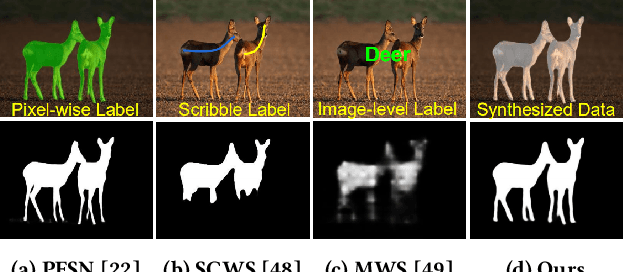

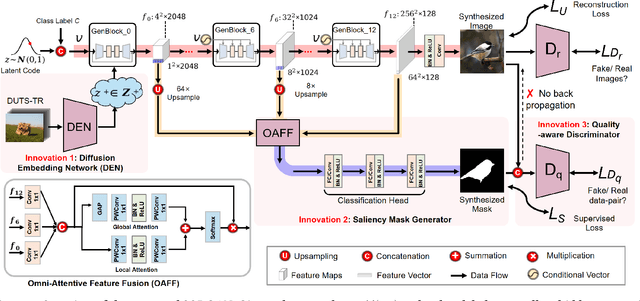
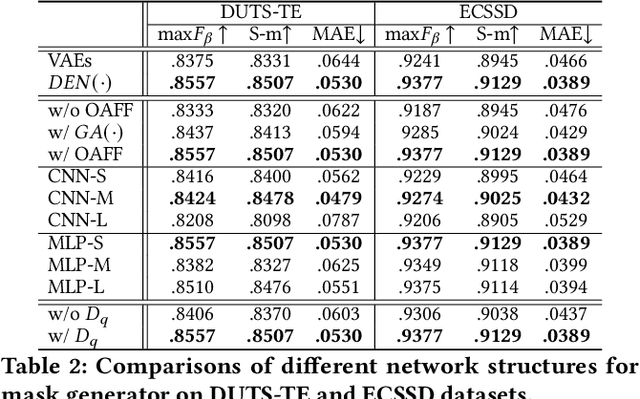
Abstract:Although deep salient object detection (SOD) has achieved remarkable progress, deep SOD models are extremely data-hungry, requiring large-scale pixel-wise annotations to deliver such promising results. In this paper, we propose a novel yet effective method for SOD, coined SODGAN, which can generate infinite high-quality image-mask pairs requiring only a few labeled data, and these synthesized pairs can replace the human-labeled DUTS-TR to train any off-the-shelf SOD model. Its contribution is three-fold. 1) Our proposed diffusion embedding network can address the manifold mismatch and is tractable for the latent code generation, better matching with the ImageNet latent space. 2) For the first time, our proposed few-shot saliency mask generator can synthesize infinite accurate image synchronized saliency masks with a few labeled data. 3) Our proposed quality-aware discriminator can select highquality synthesized image-mask pairs from noisy synthetic data pool, improving the quality of synthetic data. For the first time, our SODGAN tackles SOD with synthetic data directly generated from the generative model, which opens up a new research paradigm for SOD. Extensive experimental results show that the saliency model trained on synthetic data can achieve $98.4\%$ F-measure of the saliency model trained on the DUTS-TR. Moreover, our approach achieves a new SOTA performance in semi/weakly-supervised methods, and even outperforms several fully-supervised SOTA methods. Code is available at https://github.com/wuzhenyubuaa/SODGAN
* 9 pages, 8 figures
Boundary-Guided Camouflaged Object Detection
Jul 02, 2022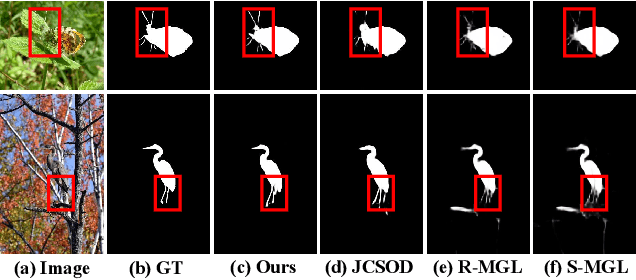
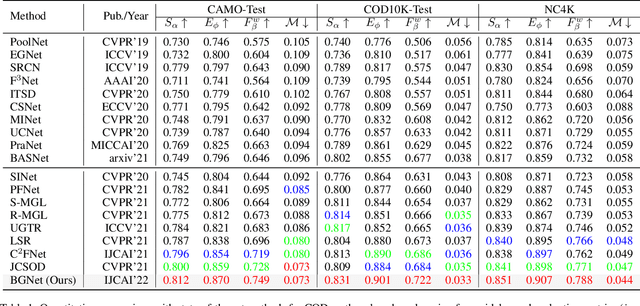
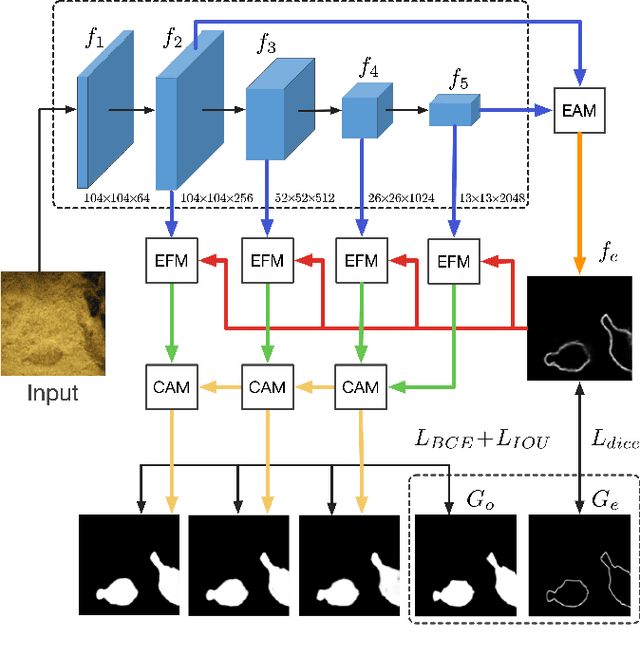

Abstract:Camouflaged object detection (COD), segmenting objects that are elegantly blended into their surroundings, is a valuable yet challenging task. Existing deep-learning methods often fall into the difficulty of accurately identifying the camouflaged object with complete and fine object structure. To this end, in this paper, we propose a novel boundary-guided network (BGNet) for camouflaged object detection. Our method explores valuable and extra object-related edge semantics to guide representation learning of COD, which forces the model to generate features that highlight object structure, thereby promoting camouflaged object detection of accurate boundary localization. Extensive experiments on three challenging benchmark datasets demonstrate that our BGNet significantly outperforms the existing 18 state-of-the-art methods under four widely-used evaluation metrics. Our code is publicly available at: https://github.com/thograce/BGNet.
* Accepted by IJCAI2022
A Comprehensive Survey on Video Saliency Detection with Auditory Information: the Audio-visual Consistency Perceptual is the Key!
Jun 20, 2022
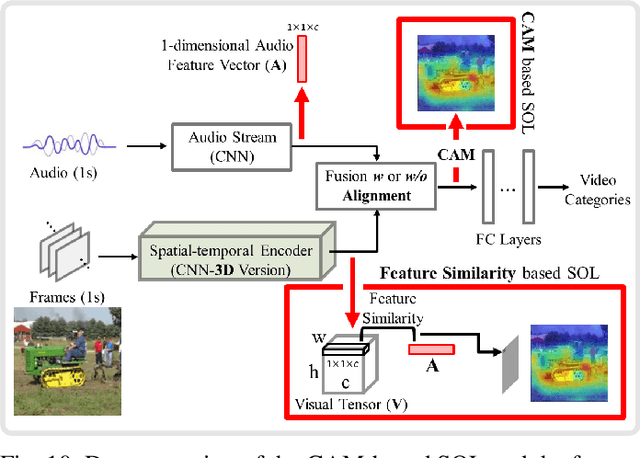
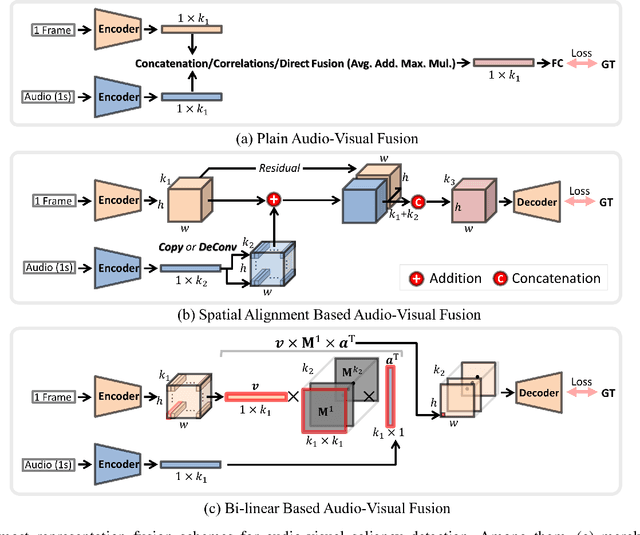
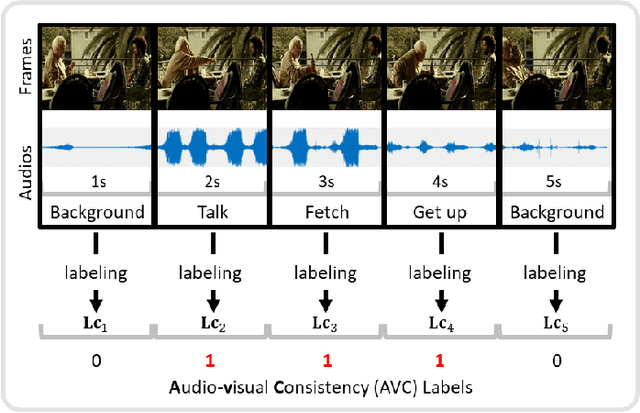
Abstract:Video saliency detection (VSD) aims at fast locating the most attractive objects/things/patterns in a given video clip. Existing VSD-related works have mainly relied on the visual system but paid less attention to the audio aspect, while, actually, our audio system is the most vital complementary part to our visual system. Also, audio-visual saliency detection (AVSD), one of the most representative research topics for mimicking human perceptual mechanisms, is currently in its infancy, and none of the existing survey papers have touched on it, especially from the perspective of saliency detection. Thus, the ultimate goal of this paper is to provide an extensive review to bridge the gap between audio-visual fusion and saliency detection. In addition, as another highlight of this review, we have provided a deep insight into key factors which could directly determine the performances of AVSD deep models, and we claim that the audio-visual consistency degree (AVC) -- a long-overlooked issue, can directly influence the effectiveness of using audio to benefit its visual counterpart when performing saliency detection. Moreover, in order to make the AVC issue more practical and valuable for future followers, we have newly equipped almost all existing publicly available AVSD datasets with additional frame-wise AVC labels. Based on these upgraded datasets, we have conducted extensive quantitative evaluations to ground our claim on the importance of AVC in the AVSD task. In a word, both our ideas and new sets serve as a convenient platform with preliminaries and guidelines, all of which are very potential to facilitate future works in promoting state-of-the-art (SOTA) performance further.
A Novel Long-term Iterative Mining Scheme for Video Salient Object Detection
Jun 20, 2022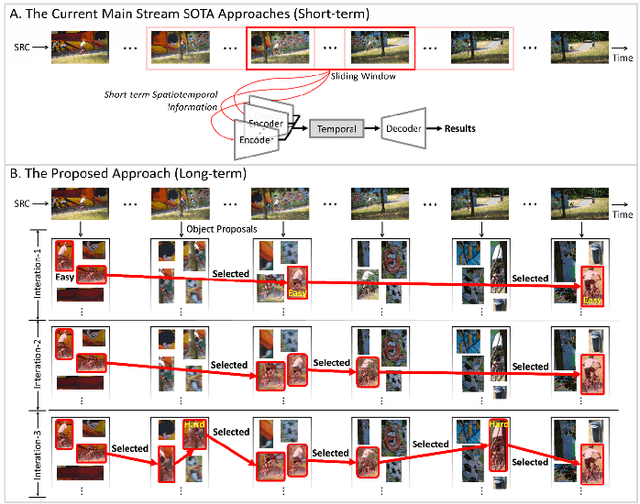
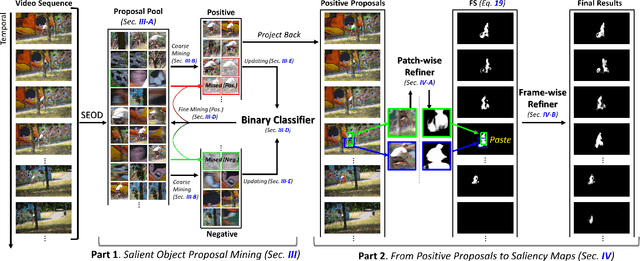
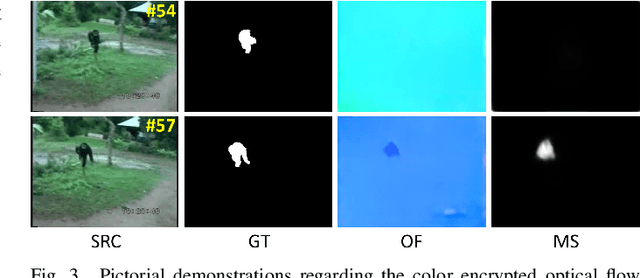

Abstract:The existing state-of-the-art (SOTA) video salient object detection (VSOD) models have widely followed short-term methodology, which dynamically determines the balance between spatial and temporal saliency fusion by solely considering the current consecutive limited frames. However, the short-term methodology has one critical limitation, which conflicts with the real mechanism of our visual system -- a typical long-term methodology. As a result, failure cases keep showing up in the results of the current SOTA models, and the short-term methodology becomes the major technical bottleneck. To solve this problem, this paper proposes a novel VSOD approach, which performs VSOD in a complete long-term way. Our approach converts the sequential VSOD, a sequential task, to a data mining problem, i.e., decomposing the input video sequence to object proposals in advance and then mining salient object proposals as much as possible in an easy-to-hard way. Since all object proposals are simultaneously available, the proposed approach is a complete long-term approach, which can alleviate some difficulties rooted in conventional short-term approaches. In addition, we devised an online updating scheme that can grasp the most representative and trustworthy pattern profile of the salient objects, outputting framewise saliency maps with rich details and smoothing both spatially and temporally. The proposed approach outperforms almost all SOTA models on five widely used benchmark datasets.
 Add to Chrome
Add to Chrome Add to Firefox
Add to Firefox Add to Edge
Add to Edge